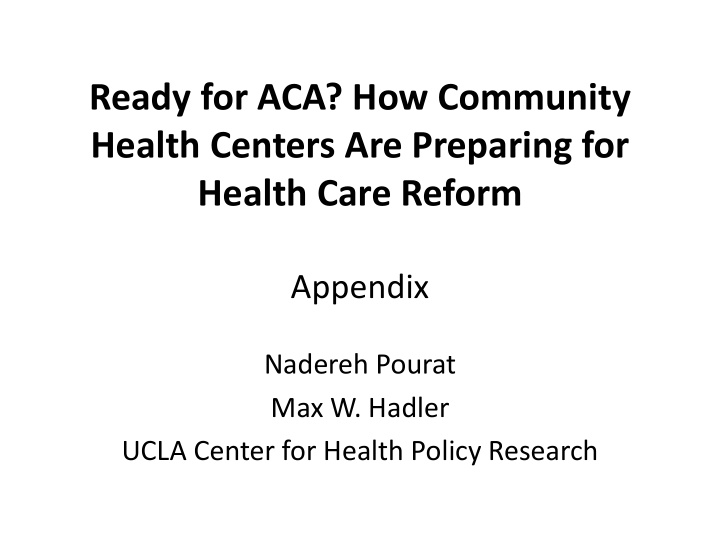



Ready for ACA? How Community Health Centers Are Preparing for Health Care Reform Appendix Nadereh Pourat Max W. Hadler UCLA Center for Health Policy Research
ACA-Ready Community Health Centers Have More Providers The “most ready” Primary care providers† CHCs are larger organizations with Clinical support staff more full-time equivalent primary Administrative staff care providers and 84 clinical and administrative 52 55 support staff than the 66 “least ready” CHCs on 47 60 33 average. 6* 17 43 14* 31 24 13 9* 1 2 3 4 5 Low Readiness High Readiness Source: UCLA analysis of 2012 primary care clinic utilization data from the Office of Statewide Health Planning and Development (OSHPD). †Primary care providers include all providers who can independently deliver care (billable encounters), including physicians, physician assistants, nurse practitioners, nurse midwives, visiting nurses, dentists, registered dental hygienists, psychiatrists, clinical psychologists, and licensed clinical social workers. *Significantly different from Level 5 CHCs (p < .05).
ACA-Ready Community Health Centers Have More Patients Larger organizations with more providers Number of patients Number of encounters and staff can provide 118,551 more visits to more patients. The “most 89,587 ready” CHCs had at 77,507 least four times more patients and 44,160 encounters than the 33,084 “least ready” CHCs. 27,607 26,587* 23,066 14,382 7,879* 1 2 3 4 5 Low Readiness High Readiness Source: UCLA analysis of 2012 primary care clinic utilization data from the Office of Statewide Health Planning and Development (OSHPD). *Significantly different from Level 5 CHCs (p < .05).
ACA-Ready Community Health Centers Have More Medi-Cal Patients Medi-Cal Other insured† Self-pay Free Other†† ACA readiness is associated with a greater proportion of encounters covered by public and private 35% 39% 42% 45% insurance, which 51% 1% supply a more 2% 8% 4% 10% 8% consistent revenue 15% 19% 9% source than self-pay, 16% 5% 9% free, or other types of 3% 48% 22% 40% payers. 34% 24% 3%* 8%* 1 2 3 4 5 Low Readiness High Readiness Source: UCLA analysis of 2012 primary care clinic utilization data from the Office of Statewide Health Planning and Development (OSHPD). †“Other insured” includes Medicare, Healthy Families, and privately insured. ††“Other” includes county indigent care programs and non-comprehensive health coverage programs, including breast cancer programs, Family PACT, the Child Health and Disability Prevention Program, and the PACE Program. *Significantly different from Level 5 CHCs (p < .05).
ACA-Ready Community Health Centers Have More Patient Revenues The “most ready” Patient revenue Grant revenue Other revenue CHCs generate significantly more revenue from the 11% 16% 18% patients they serve 37% 40% and may rely less on 28% 30% other funding sources. 42% 34% 30% 61% 53% 43% 30% 29%* 1 2 3 4 5 Low Readiness High Readiness Source: UCLA analysis of 2012 primary care clinic utilization data from the Office of Statewide Health Planning and Development (OSHPD). *Significantly different from Level 5 CHCs (p < .05).
ACA-Ready Community Health Centers Serve More Children <20 20-44 45-64 65+ 4% 4% 5% 5% 6% 24% 32% 30% 39% 38% 29% 36% 36% 36% 42% 42% 28% 28% 20% 14%* 1 2 3 4 5 Low Readiness High Readiness Source: UCLA analysis of 2012 primary care clinic utilization data from the Office of Statewide Health Planning and Development (OSHPD). *Significantly different from Level 5 CHCs (p < .05).
Community Health Center Patients are Racially and Ethnically Diverse White African-American Asian/Pacific Islander Latino 8% 10% 15% 12% 3% 3% 76% 12% 14% 13% 18% 66% 58% 57% 50% 72% 66% 61% 61% 57% 1 2 3 4 5 1 2 3 4 5 Low Readiness High Readiness Low Readiness High Readiness Source: UCLA analysis of 2012 primary care clinic utilization data from the Office of Statewide Health Planning and Development (OSHPD).
Most Community Health Center Patients are Female and Many Have Limited English Proficiency Male Female % of patients with limited English proficiency 62% 51% 50% 51% 59% 61% 62% 64% 41% 36% 49% 41% 39% 38% 36% 1 2 3 4 5 1 2 3 4 5 Low Readiness High Readiness Low Readiness High Readiness Source: UCLA analysis of 2012 primary care clinic utilization data from the Office of Statewide Health Planning and Development (OSHPD).
Community Health Centers Most Frequently Treat Endocrine and Circulatory System Issues Endocrine/Nutritional/Metabolic Circulatory Family planning Respiratory Mental Musculoskeletal/Connective tissue 4% 5% 5% 11% 5% 4% 8% 3%* 3% 3% 6% 7% 10% 6% 1% 5% 7% 7% 8% 11% 4% 13% 10% 10% 7% 18% 16% 14% 14% 13% 1 2 3 4 5 Low Readiness High Readiness Source: UCLA analysis of 2012 primary care clinic utilization data from the Office of Statewide Health Planning and Development (OSHPD).
Recommend
More recommend